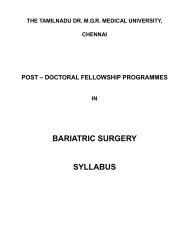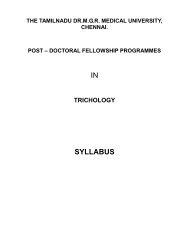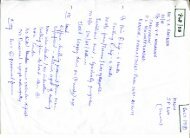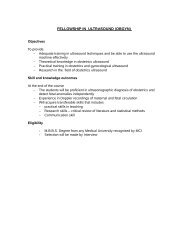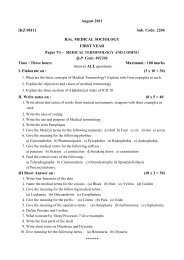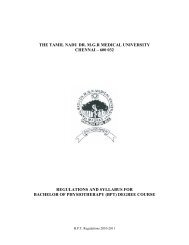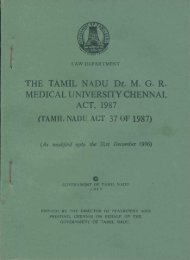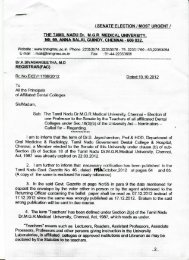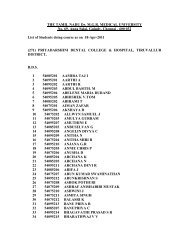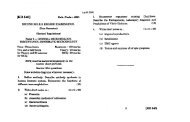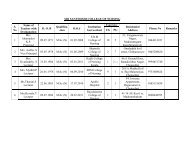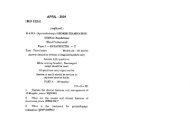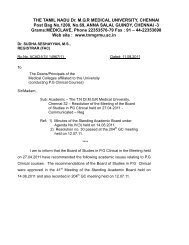M.D(Homoeopathy) - Tamil Nadu Dr. M G R Medical University
M.D(Homoeopathy) - Tamil Nadu Dr. M G R Medical University
M.D(Homoeopathy) - Tamil Nadu Dr. M G R Medical University
Create successful ePaper yourself
Turn your PDF publications into a flip-book with our unique Google optimized e-Paper software.
1<br />
The <strong>Tamil</strong> <strong>Nadu</strong><br />
<strong>Dr</strong>. M.G.R. <strong>Medical</strong> <strong>University</strong>, Chennai<br />
Notification<br />
Chennai ……………….. 2010<br />
In exercise of the powers conferred by Section 44 of The <strong>Tamil</strong> <strong>Nadu</strong> <strong>Dr</strong>. M.G.R. <strong>Medical</strong><br />
<strong>University</strong>, Madras, Act 1987 (<strong>Tamil</strong> <strong>Nadu</strong> Act 37 of 1987), the Standing Academic Board of The<br />
<strong>Tamil</strong> <strong>Nadu</strong> <strong>Dr</strong>. M.G.R. <strong>Medical</strong> <strong>University</strong>, Chennai does hereby make the following<br />
Regulations:-<br />
PART – I PRELIMINARY<br />
1. Short title and commencement : -<br />
i. These Regulations shall be called “<strong>Homoeopathy</strong> (Post Graduate Degree Course)<br />
M.D. (Hom.) Regulations 2006 of The <strong>Tamil</strong> <strong>Nadu</strong> <strong>Dr</strong>. M.G.R. <strong>Medical</strong> <strong>University</strong>,<br />
Chennai.”<br />
ii. They shall come into force with effect from the academic year 2010-11.<br />
iii. The Regulations and the syllabus are subject to modification by the Standing<br />
Academic Board from time to time.<br />
2. Definitions:- In these Regulations, unless the context otherwise requires:-<br />
(a) “Act” means the <strong>Homoeopathy</strong> Central Council Act, 1973 (59 of 1973)<br />
got amended in 2002.<br />
(b) “C.C.H.” means the Central Council of <strong>Homoeopathy</strong>, New Delhi<br />
constituted under the Act.<br />
(c) “Course” means a course of study in the subjects referred to in Part II of<br />
these Regulations.<br />
(d) “MD (Hom.)” means a post graduate degree in <strong>Homoeopathy</strong> (Doctor of<br />
Medicine in <strong>Homoeopathy</strong>) as prescribed in these Regulations.<br />
(e) A ‘Degree in <strong>Homoeopathy</strong>’ means ‘BHMS’ or its equivalent declared<br />
there to by the CCH.<br />
(f) “<strong>Homoeopathy</strong> college” means a Homoeopathic medical college or an<br />
institution affiliated to a <strong>University</strong> and recognised by the Central Council<br />
of <strong>Homoeopathy</strong> and the Central Govt. for degree course in<br />
<strong>Homoeopathy</strong>.<br />
(g) “Schedule” means the Schedule annexed to the said Act;<br />
(h) “Syllabus” and “Curriculum” means the syllabus and curriculum for<br />
different courses of study as prescribed by the <strong>University</strong> under these<br />
Regulations;<br />
(i) “Teaching Experience” means teaching experience in the subject<br />
concerned in a Homoeopathic College and includes teaching experience in<br />
the subjects of Medicine, Surgery, Obstetrics and Gynaecology gained in a<br />
<strong>Medical</strong> College, recognised by the <strong>Medical</strong> Council of India.
2<br />
PART II - COURSES OF STUDY<br />
3. Post graduate degree (Doctor of Medicine in <strong>Homoeopathy</strong> - MD (Hom.)) courses shall be<br />
in the following subjects:<br />
i. Organon of Medicine with MD (Hom.) Organon of Medicine with<br />
Homoeopathic Philosophy Homoeopathic Philosophy<br />
ii. Homoeopathic Materia Medica MD (Hom.) Materia Medica<br />
iii. Homoeopathic Repertory MD (Hom.) Repertory<br />
iv. Homoeopathic Practice of Medicine MD (Hom.) Practice of Medicine<br />
v. Paediatrics in <strong>Homoeopathy</strong> MD (Hom.) Paediatrics<br />
vi. Psychiatry in <strong>Homoeopathy</strong> MD (Hom.) Psychiatry<br />
vii. Homoeopathic Pharmacy MD (Hom.) Pharmacy<br />
4. Duration of the Course<br />
The course shall be of 3 year’s duration having two Parts I & II.<br />
Part I is of 18 months’ duration, out of which the first 12 months shall be of compulsory<br />
house job. Part II consists of 18 months devoted to speciality subjects.<br />
5. Minimum No. of Working days of the Course<br />
Each Part of the course shall consist of not less than 360 working days.<br />
6. Maximum Period for completion of the course:<br />
The maximum period allowed for completion of the course is double the duration of study<br />
of MD (Hom.) degree course as per <strong>University</strong> norms.<br />
7. Commencement of the Course<br />
The academic year for MD (Hom.) course shall commence from 1 st June of the year.<br />
8. Medium of Instruction<br />
English shall be the medium of instruction for the course.<br />
PART – III ADMISSION TO THE COURSE<br />
9. No candidate shall be admitted to MD (Hom.) course unless he has<br />
i) A Bachelor of Homoeopathic Medicine and Surgery or an equivalent qualification in<br />
<strong>Homoeopathy</strong> included in the Second Schedule to the Act, after undergoing a course<br />
of study of not less than five years and six months’ duration including one year<br />
compulsory internship<br />
OR<br />
ii) A Bachelor of Homoeopathic Medicine and Surgery (Graded Degree) or an<br />
equivalent qualification in <strong>Homoeopathy</strong> included in the Second Schedule to the Act<br />
after undergoing a course of study of not less than two tears’ duration.<br />
10. Eligibility Certificate<br />
Candidates who have passed BHMS degree course from other than the <strong>Tamil</strong> <strong>Nadu</strong> <strong>Dr</strong>.<br />
MGR <strong>Medical</strong> <strong>University</strong> before seeking admission to Post Graduate MD (Hom.) course in any of<br />
the affiliated institutions shall obtain an Eligibility Certificate from the <strong>University</strong> by remitting the<br />
prescribed fee along with the application form.
3<br />
11. Selection of Candidates<br />
The <strong>University</strong> (or) the authority entrusted by the Central Government or State<br />
Government, as the case may be, shall select candidates on merit for Post – Graduate course.<br />
Preference shall be given to candidates who have worked in rural areas for at least two years in<br />
respect of one seat in each subject as per merit.<br />
12. Enrolement of Candidates<br />
The candidates admitted provisionally shall apply to the <strong>University</strong> for enrolment with in 7<br />
days from the date of admission in the prescribed form which will be downloaded from the<br />
<strong>University</strong> web site along with the provisional admission card issued by the college / selection<br />
committee. Enrolment Certificate will be issued by the <strong>University</strong> for admission to MD (Hom.)<br />
course against a fee of Rs.125/- or that may be prescribed by the authorities of the <strong>University</strong> from<br />
time to time.<br />
13. Registration:<br />
i. A candidate admitted to the MD (Hom.) course in any of the affiliated institutions of<br />
The <strong>Tamil</strong> <strong>Nadu</strong> <strong>Dr</strong>. M.G.R. <strong>Medical</strong> <strong>University</strong>, Chennai, shall register with the<br />
<strong>University</strong> by remitting the prescribed fee along with the application form for<br />
registration duly filled in by forwarding it to the Controller of Examinations of this<br />
<strong>University</strong> through the Head of the affiliated institution within 60 days from the cut-off<br />
date.<br />
ii. Every candidate shall also be required to submit the following namely within in 6<br />
months from the cut off date of admission or before the date notified by the <strong>University</strong><br />
through proper channel<br />
a. Statement showing the name of the Guide / Supervisor (co-guide / Cosupervisor<br />
wherever necessary) for Thesis / Dissertation.<br />
b. Written consent of the Guide / Supervisor agreeing to supervise and guide.<br />
c. The topic of the thesis / dissertation approved of the Guide /<br />
Supervisor (A change in the topic shall be permissible at the discretion of<br />
the Guide / Supervisor)<br />
d. A synopsis containing particulars of proposed dissertation duly got<br />
approved by the Guide / Supervisor concerned.<br />
14. Readmission after break of study<br />
Readmission after break of study shall be as per the procedure in the <strong>University</strong><br />
Regulations concerned.<br />
15. Migration / Transfer<br />
Migration / Transfer of candidates from a college to another college affiliated under<br />
this <strong>University</strong> or from another <strong>University</strong> shall not be granted.<br />
PART – IV - CURRICULUM OF STUDIES<br />
16. Curriculum of the courses shall comprise of the following:<br />
A. GENERAL SUBJECTS<br />
i. Man in Health (Holistic Concept)<br />
The man in Health (Holistic Concept) - structural, functional and psychological<br />
organisation of Man and his adaptation to the environment in health. The study of<br />
Anatomy, Physiology, Biochemistry, Biophysics and Psychology is integrated in<br />
such a manner to help the practical application of this knowledge in clinical<br />
medicine.
4<br />
ii. Man in Disease (Holistic Concept)<br />
The man in Disease (Holistic Concept) structural functional and psychological<br />
organisation of the sick and his deficient adaptation to his environment.<br />
The study of Pathology (Psychological, functional and structural deviations from<br />
the state of Health) should include a probe into the evolution by phenomenon of<br />
disease, paying attention to the cause-effect relationship (viz. the effects of<br />
extrinsic (micro organisms, parasites, viruses and other stimuli) and intrinsic<br />
(susceptibility based on miasms) factors along with their current interpretations<br />
and the abnormal expressions of the sick pervading his whole being.<br />
iii. History of Medicine. Scientific Methodology including Research Methodology and<br />
Statistics.<br />
History of Medicines – evolution with special emphasis on Hahnemann’s<br />
contribution to medicine in general.<br />
Basic Concepts of Logic, Philosophy and Scientific Methodology including<br />
Research Methodology and Statistics.<br />
B. SPECIALITY SUBJECTS:<br />
A candidate for M.D.(Hom.) shall opt any one of the subjects as his speciality at the time of<br />
admission and the degree shall be awarded in that speciality.<br />
In each of the speciality subjects, a deeper understanding than already acquired is<br />
expected to be achieved covering the recent advances made and discernible in the subjects<br />
concerned.<br />
a. Clinical :<br />
i) Organon of Medicine with Homoeopathic Philosophy<br />
ii) Homoeopathic Materia Medica<br />
iii) Repertory<br />
iv) Practice of Medicine<br />
v) Paediatrics<br />
vi) Psychiatry.<br />
Note : The applied part of clinical subjects deals with the application of the principles<br />
of <strong>Homoeopathy</strong> in practice. To achieve this effectively a thorough<br />
knowledge in:<br />
a. Dynamics and methods of case taking.<br />
b. Diagnosis and differential diagnosis of diseases with various, physical, clinical<br />
and laboratory findings.<br />
c. Analysis and synthesis of cases with Hahnemannian evolutionary totality.<br />
d. Selection of medicine including Repertorisation and comparative study of<br />
Materia Medica.<br />
e. Selection of Potency and Dose.<br />
f. Second prescription.<br />
g. Remedy response and prognosis.<br />
h. Management of the cases in general, therapeutic and accessory. (Necessary case<br />
oriented method of study should be adopted here by intergrating all disciplines<br />
relevant).<br />
b. Non- clinical:<br />
i) Homoeopathic Pharmacy<br />
Every candidate has to study the General Subjects mentioned above which constitute the<br />
Part I examination, in addition to the subject in which he is specialising. The subject of<br />
speciality shall constitute the Part II examination.
5<br />
17. Method of Training<br />
i. The emphasis should be on service training and not on didactic lectures. The candidates<br />
should take part in seminars (once in two weeks) group discussions (every day), clinical<br />
meetings (once a week) and journal club (once a week). The candidate should be<br />
required to write a thesis or dissertation with detailed commentary which would<br />
provide him with necessary background of training in research methods and techniques<br />
along with the art of writing research papers through learning and making use of<br />
library. The candidate shall be in the campus and shall be given graded responsibility in<br />
the management and treatment of patients entrusted to his care. He shall participate in<br />
teaching and training of the under-graduate students or interns.<br />
ii. Every Post –Graduate candidate shall maintain a work diary to record the skills he has<br />
acquired during house job got rectified by the Head of Department / Guide concerned<br />
under whom he has undergone the training. The Head of the Department / Guide shall<br />
scrutinize the work diary once in every 3 months. On successfully completing the house<br />
job, the candidate should summarise the contents and get the work diary certified by the<br />
Head of Department / Guide. A work diary should be submitted for scrutiny by the<br />
Board of Examiners three months before the commencement of the Part I Examination.<br />
PART – V – SYLLABUS - Demarcation of Theory Papers<br />
18. M.D (Hom) Part I Examinations – GENERAL SUBJECTS<br />
(Common to all Subjects of Speciality)<br />
Paper I: Man in Health (Holistic Concept) - 100 Marks<br />
(The following topics should be studied in the very same perspective as<br />
mentioned in the Curriculum of Studies)<br />
1. Concept of Health – Different Approaches – Holistic Concept – Definitions,<br />
Dimensions and Determinants of Health – Factors influencing Health<br />
2. Applied Anatomy: General anatomical considerations of various organs and systems<br />
in Health.<br />
3. Applied Physiology & Biochemistry, including physiological and Biochemical<br />
parameters relating to various systems and special senses to assess the State of Health.<br />
4. Psychological organization of Man: Introduction & Definition of Psychology<br />
- Mental faculties: Attention, Perception, Intelligence, Memory, Emotion,<br />
Thinking, Personality.<br />
- Mental Mechanisms<br />
- Methods of Psychological Assessment.<br />
Paper II: Man in Disease (Holistic Concept) – 100 Marks<br />
(The following topics should be studied in the very same perspective as<br />
mentioned in the Curriculum of Studies)<br />
1. Concept of Disease – Definitions – Holistic Approach – Distinction between Disease,<br />
Illness and Sickness.<br />
2. Causation of Diseases – Multifactor Theory<br />
a. Environment: External – Biological, Physical, Psychological<br />
b. Agent: - Biological, Physical, Chemical, Mechanical, Social, Nutritional<br />
c. Host: Intrinsic factors – Heredity, General consideration of the Concept of<br />
Miasms<br />
3. Fundamentals of General Pathology in Disease process
6<br />
Paper III: History of Medicine and Statistics & Research Methods - 100 Marks<br />
Section A: History of Medicine - 50 marks<br />
1. Evolution of <strong>Medical</strong> History – Hahnemann’s contributions to Medicine in general<br />
2. General Philosophy – Introduction – Definition & Scope – Philosophy & Science<br />
3. Logic – Inductive & Deductive (on the basis of Aristotle), Lord Bacon & J.S. Mill)<br />
4. Doctrine of Force (Leibinitz & Henry Bergson)<br />
5. Part & Whole relation – Organic Whole (Aristotle & Hegel)<br />
Section B: Statistics & Research Methods - 50 marks<br />
1. Definition and Scope of Statistics<br />
2. Source and Presentation of Statistical data Primary data – Secondary data –<br />
classification – tabulation - Presentation of Statistical data by diagrams, graph, chart<br />
etc.<br />
3. Measures of Central Tendency or Averages<br />
Introduction – different averages – definitions – merits and demerits – Partition values<br />
– graphical location of partition values<br />
4. Introduction – definition of different measures of variation, merits and demerits –<br />
coefficient of variation – skew ness, kurtosis<br />
5. Correlation and Regression<br />
Scatter diagram – correlation – limits correlation coefficient – rank coefficient – Lines<br />
of regression coefficient.<br />
6. Sampling Theory<br />
Introduction – Advantages of Sampling – Principle steps in a sample survey –<br />
different methods of sampling – sampling and non – sampling errors<br />
7. Theory of Probability<br />
Introduction – definition of various terms – Law of addition of Probability –<br />
multiplication – Law of probability – conditional probability.<br />
8. Theoretical Distribution<br />
Introduction – Binomial distribution – Normal distribution – Chi square distribution –<br />
t- distribution – Standard error<br />
9. Tests of Significances<br />
Introduction – Null Hypothesis – Alternative Hypothesis – level of significance text –<br />
Type I error – Type II error – Test of significance for single proportion – test of<br />
significance for difference of proportions – Test of significance of single means –<br />
Test of significance for differences of means – Chi Square test – t- test.<br />
10. Research Methodology<br />
Introduction – Defining the research problem – research design –epidemiological<br />
studies – Clinical trials – writing research reports etc.
7<br />
19. MD (Hom.) Part II Examinations – SPECIALITY SUBJECTS<br />
I. MD (Hom.) - ORGANON OF MEDICINE WITH HOMOEOPATHIC<br />
PHILOSOPHY<br />
Paper I. Organon of Medicine - 100 Marks<br />
1. Different editions of Organon of Medicine – Critical study<br />
2. Lesser Writings of Hahnemann<br />
3. Theory of Chronic Miasms<br />
Paper II – Homoeopathic Philosophy & Practice of <strong>Homoeopathy</strong> in Specialities<br />
- 100 Marks<br />
Section A: Homoeopathic Philosophy - 50 Marks<br />
Views & interpretations of stalwarts in <strong>Homoeopathy</strong> like Kent, Stuart Close, H.A.<br />
Robert, Dunham, Richard Hughes, Boger and J.H. Allen on Hahnemannian concepts<br />
and fundamentals of <strong>Homoeopathy</strong>. It also aims at making a comparative study of the<br />
above views and interpretations with a view to bringing out the relative merits of the<br />
individual contribution to the Hahnemannian concepts of <strong>Homoeopathy</strong>.<br />
Section B: Practice of <strong>Homoeopathy</strong> in Specialities - 50 Marks<br />
(Application of Principles of <strong>Homoeopathy</strong> in Practice)<br />
Practice of <strong>Homoeopathy</strong> in Medicine, Surgery, Obstetrics & Gynaecology<br />
II. MD (Hom.) MATERIA MEDICA<br />
Paper I Basic Materia Medica - 100 Marks<br />
1. Source & evolution of Materia Medica, <strong>Dr</strong>ug proving, and collection of<br />
symptoms – classification of symptoms, Construction of Materia<br />
Medica, Types of Materia Medica.<br />
2. Science and Philosophy of Materia Medica<br />
3. Study of Materia Medica<br />
4. Scope and Limitations of Materia Medica<br />
5. Sources of <strong>Dr</strong>ugs – Family and Group Characteristics and <strong>Dr</strong>ug<br />
relationship.<br />
6. 100 Polychrest <strong>Dr</strong>ugs (Appendix 1)<br />
Paper II – Comparative Materia Medica & Practice of <strong>Homoeopathy</strong> in Specialities<br />
- 100 Marks<br />
Section A: Comparative Materia Medica - 50 Marks<br />
Comparative study of symptoms, <strong>Dr</strong>ug pictures and Therapeutic indications of<br />
all drugs including old, new and rare ones with special emphasis on Polychrest<br />
drugs.<br />
Section B: Practice of Homeopathy in Specialities - 50 marks<br />
(Application of Materia Medica in Practice of <strong>Homoeopathy</strong>)<br />
Practice of <strong>Homoeopathy</strong> in Medicine, Surgery, Obstetrics & Gynaecology
8<br />
III. MD (Hom.) REPERTORY<br />
Paper I – Case Taking & Repertorisation - 100 Marks<br />
Section A: Case Taking - 50 marks<br />
1. Dynamics and methods of case taking<br />
2. Definitions and classifications of symptoms.<br />
3. Concept of Totality of symptoms.<br />
4. Case analysis and Anamnesis.<br />
5. Evaluation of symptoms.<br />
Section B: Repertorisation - 50 marks<br />
1. Source and origin of Repertory – chronological development.<br />
2. Classification of Repertories into different groups.<br />
3. Terminology: Meaning of different technical terminology used in<br />
Repertories.<br />
4. Study of different individual groups of Repertories<br />
a. Logical – Utilitarian group – Boenninghausen, Boger, Kent, Synthetic<br />
Repertory, Synthesis and Murphy.<br />
b. Puritan – Gentry and Knerr<br />
c. Special, Regional or Particular Group of Repertories – Bell’s Diarrhoea,<br />
H.C. Allen’s Fever, Minton’s Uterine Diseases, Beridge’s Eye and<br />
Dougle’s Skin.<br />
d. Different Methods of Repertorisation<br />
f. Computer Repertorisation – Basic Knowledge of Computer application in<br />
Homoeopathic Repertorisation.<br />
g. Merits and Demerits of Different Repertories.<br />
Paper II - Practice of <strong>Homoeopathy</strong> in Specialities - 100 Marks<br />
(Use of Repertories in Practice of <strong>Homoeopathy</strong>)<br />
Practice of <strong>Homoeopathy</strong> in Medicine, Surgery, Obstetrics & Gynaecology<br />
IV. MD (Hom.) PRACTICE OF MEDICINE<br />
Every disease should be studied so as to understand it in relation to etiology and<br />
pathogenesis, considering both Internal (fundamental cause i.e. Psora, Syphilis, Sycosis) and<br />
External Causes (Exciting and Maintaining ), its Pathology, Clinical features, Investigations,<br />
Differential Diagnosis, Complications and its Homoeopathic management including miasmatic<br />
analysis, general management etc.<br />
Paper I - General Medicine including Tropical Medicine - 100 Marks<br />
Section A: - 50 marks<br />
1. Introduction to Principles and Practice of Clinical Medicine<br />
2. Environmental Diseases, including Occupational Health<br />
3. Water and electrolyte disturbance, Acid – Base imbalance<br />
4. Poisoning<br />
5. Nutritional and Metabolic Disorders<br />
6. Clinical Genetics and Molecular Biology<br />
7. Health Economics – National Health Programmes<br />
8. Current National / International Research / Trials on Diseases.<br />
9. Preventive Medicine – Basics – Vaccines and the role of <strong>Homoeopathy</strong><br />
10. Infection and Immune failure<br />
11 Tropical Diseases<br />
12. Venereology and Leprology
9<br />
Section B: 50 marks<br />
1. Cardiovascular diseases<br />
2. Respiratory diseases<br />
3. Kidney and Genito – Urinary diseases<br />
4. Endocrine diseases<br />
5. Diabetes Mellitus<br />
6. Gastro Entrology, Diaseses of Hepatobiliary System & Pancreatic diseases<br />
7. Haematology<br />
8. Musculo Skeletal disorders<br />
9. Nervous System disorders<br />
10. Dermatology<br />
Paper II - Practice of <strong>Homoeopathy</strong> in Specialities<br />
1. Paediatrics<br />
2. Psychiatry<br />
3. Geriatrics<br />
- 100 Marks<br />
4. Oncology<br />
5. Critical Care and Emergency Medicine<br />
6. Palliative Care and Pain Management<br />
V. MD (Hom.) PAEDIATRICS<br />
Every disease should be studied so as to understand it in relation to etiology and<br />
pathogenesis, considering both Internal (fundamental cause i.e. Psora, Syphilis, Sycosis) and<br />
External Causes (Exciting and Maintaining ), its Pathology, Clinical features, Investigations,<br />
Differential Diagnosis, Complications and its Homoeopathic management including miasmatic<br />
analysis, general management etc.<br />
Paper I General Pediatrics - 100 Marks<br />
• Overview of child health, scope of <strong>Homoeopathy</strong> in treating the diseases of children<br />
• Ethical issues in Pediatrics<br />
• Normal child, portraits of child constitutions in Materia Medica<br />
• Growth and development of a child and relevance of miasmatic influences during the<br />
development of children.<br />
• Child nutrition<br />
• Pathophysiology of body fluids and fluid therapy and relevance of biochemic therapy<br />
• Critical care Pediatrics<br />
• Neonatal infections, congenital abnormalities, genetic disorders.<br />
• Allergy in children<br />
• Infectious diseases<br />
• Immunological disorders<br />
• Psychological diseases<br />
• Environmental diseases
Paper II Systemic Pediatrics -100 Marks<br />
10<br />
• Digestive system<br />
• Respiratory system<br />
• Cardio-vascular system<br />
• Loco motor system<br />
• Kidney and Genito urinary diseases<br />
• Endocrinology<br />
• Metabolic disorders & Diabetis Mellitus<br />
• Haematology<br />
• Nervous system diseases<br />
• Special sense organs including Eye, Ear and Skin<br />
VI. MD (Hom.) PSYCHIATRY<br />
It is aimed at training the basic Homoeopathic graduate in the field of Psychiatry, and<br />
treating the psychiatric ailments based on the principles of <strong>Homoeopathy</strong> and also training them in<br />
counseling and behavioral therapy to ensure healthy citizens in the present hectic and stressful<br />
conditions of the society.<br />
Paper – I General Psychiatry - 100 Marks<br />
a. Historical aspect relevant to the study of Mental Diseases<br />
1. Historical review of the development of Psychiatry<br />
2. Hahnemann’s contribution to the understanding of Mental Disorders.<br />
b. Behavioral and Social Sciences relevant to Mental Disorders<br />
General Psychology with schools of Psychology, Theories of Personality<br />
Development, Special dimensions of behavior & current issues, Doctor –<br />
Patient relationship, Patient interviewing & study of Therapeutic relationship.<br />
c. Psychological Foundations of Clinical Psychiatry:<br />
Psycho-bio-social Model of disease, Neuro-Physiology, Neuro-Chemistry,<br />
Neuro-Anatomy, Neuro-Psychology, Neuropathology, Psycho-<br />
Neuroimmunology, Neuropsychiatry, Neurological examination with<br />
Neuroimaging related to Mental Disorders.<br />
d. Psychopathology<br />
1. Concept of Normality & Deviance in Behavior Psychiatric<br />
symptomatology<br />
2. Etiopathogensis of Psychiatric disorders, Concept of stress,<br />
Psychological testing Classification of Psychiatric Disorders.<br />
Paper - II Clinical Psychiatry - 100 Marks<br />
a. Clinical Psychiatry :<br />
1. <strong>Medical</strong> Disorders related to Psychiatry<br />
2. Organic Brain Syndromes<br />
3. Substance – related Disorders<br />
4. Schizophrenic Disorders<br />
5. Affective Disorders<br />
6. Somatoform Disorders<br />
7. Dissociative Disorders<br />
8. Anxiety Disorders<br />
9. Personality Disorders<br />
10. Sexual & Gender Identify Disorders
11<br />
11. Habit Disorders<br />
12. Sleep Disorders<br />
13. Adjustment Disorders<br />
14. Impulse Disorders and other Behavioral Disorders<br />
15. Disorders of Infancy, Childhood and Adolescence<br />
16. Psycho-physiological and Physio-psychological Disorders and Consultation<br />
Liaison Psychiatry.<br />
17. Community Psychiatry with special reference to contemporary problems.<br />
18. Psychiatry in the educational setting<br />
19. Geriatric Psychiatry<br />
20. Socio-cultural Psychiatry<br />
21. Forensic Psychiatry and Ethics in Psychiatry<br />
22. Preventive aspects of Mental Disorders<br />
23. Recent advances.<br />
b. Homoeopathic aspect of Clinical Psychiatry<br />
Case receiving, Examining, Recording and Processing the cases of Mental<br />
Disorders on Homoeopathic principle including Miasmatic analysis.<br />
c. Treatment of Psychiatric Disorders<br />
1. Homoeopathic Management – Principles and Applications<br />
2. Assessment of Sensitivity and Susceptibility in mental disorders<br />
3. Planning and Programming of Homoeopathic Psychiatric treatment<br />
4. Use of Repertories in the selection of Similimum<br />
5. Psychological Treatments<br />
6. Role and use of Adjuvent therapies and their role in Rehabilitation –<br />
e.g. Medications, Reiki, Pranic healing, Yoga etc.<br />
7. Management of co-existent Physical Disorders<br />
d. Principles of Clinical Research in Psychiatry<br />
1. Statistical Methods<br />
2. Research Methodology.<br />
VII. MD(Hom.) HOMOEOPATHIC PHARMACY<br />
Paper I 100 Marks<br />
1. Introduction, Source, Identification, Collection,Preparation, Potentization, Preservation,<br />
Prescription, Dispensing of Homoeopathic Medicines.<br />
2. Standardization of drugs and vehicles through analytical methods and techniques,<br />
biological, mechanical, chemical, toxicological properties and characteristics,<br />
laboratory methods of drug study, medical and non – medical uses of drugs.<br />
3. Homoeopathic drug proving, spheres of actions and affinities, proving on healthy<br />
human beings, animal and reproving.<br />
4. Potency, Posology, Duration of action.<br />
Paper II 100 Marks<br />
1. Experimental Pharmacology.<br />
2. <strong>Dr</strong>ugs Laws and Legislations relating to Homoeopathic Pharmacy :<br />
A basic idea about the <strong>Dr</strong>ugs and Cosmetic Act 1940 (23 of 1940), The Prevention<br />
of Illegal Trafficking of Narcotic <strong>Dr</strong>ugs and Psychotropic Substances Act 1988 (46<br />
of 1988): The <strong>Dr</strong>ugs and controls Act 1950 (26 of 1950), The <strong>Dr</strong>ugs and Magic<br />
Remedies (objectionable advertisement) Act 1854 (21 of 1954): The Medicinal<br />
Toilet Preparation (excise duties Act 1955) (16 of 1955), The Poison Act 1919 (12<br />
of 1919) the Homoeopathic Central Council Act 1973 (59 of 1973). The Pharmacy<br />
Act of 1948 (8 of 1948).<br />
3. Industrial Pharmacy.
12<br />
PG Training in Homoeopathic Pharmacy<br />
1. One year Housemanship with collaboration of Homoeopathic industries which includes.<br />
a. 1 month training in pharmaceutical manufacturing house within <strong>Tamil</strong> <strong>Nadu</strong>.<br />
b. 1 month training in pharmaceutical manufacturing house outside <strong>Tamil</strong> <strong>Nadu</strong><br />
c. Visiting of <strong>Dr</strong>ug testing Laboratories<br />
2. Training in Hospital Pharmacy with emphasis on the following<br />
a. Organisation of Hospital Pharmacy<br />
b. Responsibilities of Hospital Pharmacist<br />
c. Pharmacy and Therapeutic committee<br />
d. Organisation of Medicine store<br />
e. Purchase and inventory control – Principles, Purchases, procedures<br />
f. <strong>Dr</strong>ug distribution system in Hospitals.<br />
g. Out patient dispensing – methods adopted<br />
h. Dispensing of drugs to inpatients<br />
i. Translation of Prescriptions, proper labeling, finishing and wrapping of<br />
articles neatly.<br />
3. Principles of Industrial management and Marketing Management, training has to be given<br />
in Institute of Management.<br />
4. For Pharmacognosy studies, cultivation etc, visit Botanical garden including Tropical<br />
Botanical Garden.<br />
5. Herbarium preparation<br />
6. Medicinal garden preparation<br />
Practical Examination on Homoeopathic Pharmacy<br />
1. Analysis of drugs<br />
2. Pharmacognostic study<br />
3. Microscopic study<br />
PART – VI – EXAMINATIONS<br />
20. The Examination shall be conducted in Two Parts, namely<br />
a. M.D. (Hom.) Part - I, which is to be held six months after completion of<br />
house job.<br />
b. M.D. (Hom.) Part – II, which is to be held on expiry of one year and six<br />
months after Part I examination.<br />
21. Commencement of Examinations:<br />
There shall be two sessions of <strong>University</strong> examinations in an academic year, viz. 15 th<br />
November and 15 th May. If the date of commencement of the examination falls on Saturdays,<br />
Sundays or declared Public Holidays, the examination shall begin on next working day.
13<br />
22. Cut-off Date for Admission to Examinations<br />
The candidates admitted to the course shall be registered to take up their Part-I<br />
examinations in November of the next calendar year.<br />
23. Attendance Requirements for Admission to Examination<br />
1. The candidate pursuing the course should work in the concerned department of the<br />
institution where he studies for full period as a full time student.<br />
Note: No candidate should join any other course of study or appear for any other<br />
examination conducted by this <strong>University</strong> or any other <strong>University</strong> in India or abroad during<br />
the course of study.<br />
2. Each Part of the course shall be taken as a unit for the purpose of calculating attendance.<br />
3. The students shall attend the Symposia, Seminars, Conferences, Journal review meetings,<br />
Clinical Case presentations, and Lectures as prescribed by the department and not absent<br />
himself without valid reasons.<br />
4. 80% of attendance shall be mandatory for the candidates who sit for the <strong>University</strong><br />
Examination of MD (Hom.) course in this <strong>University</strong> and no condonation shall be allowed.<br />
5. The students who fail to complete the course as per Regulations shall not be permitted to<br />
appear for the <strong>University</strong> examinations.<br />
24. Every candidate seeking admission to Part I examination shall submit an application to the<br />
<strong>University</strong> with the following, certificates got countersigned by the PrincIpal.<br />
a. A certificate from his H.O.D. / Guide (Supervisor) about the completion of the course of<br />
studies with a minimum of 80% attendance separately in Theory and Practicals / Clinicals of the<br />
subjects in which the candidate is seeking admission to examination.<br />
b. A certificate from his H.O.D. / Guide (Supervisor) about the satisfactory completion of<br />
house job in the Collegiate Hospital or a similar one satisfying the requirement in the Department<br />
concerned in the cases of Clinical and Non-clinical subjects as the case may be.<br />
25. Part I - M.D. (Hom.) examination shall be held in General Subjects and it shall consist of:<br />
i) One Theory paper in each of General Subjects of not less than three hours<br />
duration carrying 100 marks.<br />
ii) Viva-voce/ Practical examination in each General Subject to be held by not<br />
less than three examiners together out of which one shall be the Supervisor<br />
(Guide)<br />
The examiners shall jointly assess the knowledge of the candidate for reporting the result<br />
to the <strong>University</strong> as either passed or failed. If a candidate fails to get a separate minimum of 50%<br />
in each paper and Viva Voce he will not be declared passed in the Part I examination.
Paper<br />
Subjects<br />
14<br />
26. MD (Hom) Part – I - General Subjects<br />
Distribution of Marks<br />
Durati<br />
on of<br />
Hours<br />
Theory<br />
Vivavoce<br />
Practical<br />
Total<br />
Max.<br />
I Man in Health 3 100 50 50* 200 100<br />
II Man in Disease 3 100 50 50* 200 100<br />
III<br />
History of Medicine,<br />
Statistics & Research<br />
Methods<br />
Pass<br />
3 100 50 50** 200 100<br />
* Practical examination can be conducted by arranging specimens / spotters.<br />
** The practical examination may include statistical technique and research methodology<br />
27. Every candidate seeking admission to the Part II examinations shall submit a Dissertation of<br />
not less than 10000 words. The Dissertation shall form the basis of viva-voce examination.<br />
Every candidate shall prepare and submit four printed or typed copies of his Thesis /<br />
Dissertation to the <strong>University</strong> for its approval not later than six months ahead of the<br />
examination got duly approved and countersigned by his Guide / Supervisor in the subject<br />
concerned. The Thesis shall embody the result of the candidate’s own research. The<br />
candidate shall indicate in his thesis in what respect his thesis is a contribution advancing<br />
the knowledge in the subject. The thesis should be submitted to the Guide / Supervisor<br />
at least earlier by 3 months than the time fixed for submitting it to the <strong>University</strong>.<br />
The Guide / Supervisor should have to certify that this work has not previously formed the basis<br />
for award of any degree or diploma and that the work is the record of the candidate’s personal<br />
efforts. The Thesis shall be scrutinized by the examiners appointed to conduct the examinations.<br />
The examiners will report whether the thesis should be accepted or rejected or may make<br />
suggestions, as they deem fit. The candidate will be allowed to appear for the Part II Examination<br />
after the thesis is approved. The candidate whose thesis has not been approved may be permitted to<br />
submit the thesis within not less than six months and not more than one year after rejection.<br />
The candidate shall be allowed to appear for the Part II examination one month after the<br />
examiners accept the Dissertation.<br />
28. Every candidate seeking admission to Part II Examination shall submit an application to the<br />
<strong>University</strong> with the remittance of prescribed fee along with the following certificates<br />
countersigned by the Principal of the Homoeopathic College in which the underwent the<br />
course.
15<br />
1. A certificate showing that he has passed Part I Examination<br />
2. A certificate from his Guide / Supervisor about the completion of studies with a<br />
minimum of 80% attendance separately in theory and Practical / Clinical of the<br />
subjects in which the candidate is seeking admission to examination.<br />
3. A record of training programme of each candidate indicating the various items that<br />
constitute the training with an assessment of performance shall be submitted to be<br />
<strong>University</strong> by the guide for approval and permission to appear for the examination.<br />
29. Part II MD(Hom.) examination shall be held in the subject speciality opted by the candidate at<br />
the time of admission and shall consist of<br />
i) Two written Theory papers, each of not less than three hours’ duration carrying<br />
100 marks.<br />
ii) Two Viva-voce - one on Dissertation and another one in the Subject of<br />
Speciality.<br />
iii) One Practical / Clinical examination in the subject of speciality to test the<br />
candidate’s acumen and his ability and working knowledge in the practice of the<br />
speciality. There shall be four Examiners together, including one Supervisor<br />
(Guide) in the subject.<br />
30. MD (Hom) Part - II Examination<br />
Distribution of Marks for all Subjects of Specialty<br />
Paper<br />
Duration<br />
of Hours<br />
I 3 100<br />
II 3 100<br />
Theory Viva-voce<br />
Max. Pass Mini. Maxi.<br />
100<br />
Dissertation-50<br />
+<br />
Spl. Sub – 50<br />
100<br />
Pass<br />
Mini.<br />
Practical /<br />
Clinical<br />
Maxi.<br />
Pass<br />
Mini.<br />
Total<br />
50 100 50 400<br />
31. A candidate who fails in the Examination shall be permitted to appear again for the<br />
examination without undergoing any further course of study. But if however, a candidate<br />
fails to pass the examination with in the four consecutive chances immediately after taking<br />
the examination, he has to put in an additional course of six months before he is allowed to<br />
appear for the next examination.<br />
32. Question Patterns in general for Theory examinations:<br />
Questions must also reflect latest advances in the subject concerned, Each paper is based<br />
on the following pattern.<br />
Mark Time<br />
a. 20 MCQ each 1 mark (20 xl) 20 marks 0.20 hrs.<br />
b. Six shot notes each 5 marks (6x5) 30 marks<br />
c. Two essay questions each 15 marks (2x15) 30 marks 2.40 hrs.<br />
d. One long essay (1x20) 20 marks<br />
-------------- -----------------<br />
Total 100 marks 3.00hrs.<br />
------------- ----------------
33. Declaration of Results<br />
16<br />
The Board of Examiners shall jointly assess and finalise the results and recommends that a<br />
candidate be declared passed with distinction / passed / failed, in each examination. Those<br />
candidates who secure 75% or above marks are declared as passed with distinction and graded ‘A’.<br />
Those candidates who secure 50% or above marks are declared as passed and graded ‘B’ and those<br />
candidates who secure below 50% are declared as failed and graded ‘C’. The candidates will only<br />
be issued with the gradation list.<br />
Note: First Class and Distinction shall be awarded only to those who pass in all<br />
subjects in the first attempt itself, and within the minimum duration of the course<br />
prescribed.<br />
34. Examiners<br />
i. The qualifications for the Examiners shall be the same as of the Guides<br />
A panel of examiners shall be prepared by the <strong>University</strong> for a period of two years subject to the approval<br />
of the Central Council of <strong>Homoeopathy</strong>.<br />
ii. At least 50% of the examiners in a subject shall be externals. Guide / Supervisor,<br />
Co-Guide / Co-Supervisor shall be one of the examiners in the speciality subject<br />
concerned.<br />
iii. Each paper shall be valued independently by each of the examiners and the average<br />
shall be taken.<br />
35. Board of Examiners<br />
The <strong>University</strong> will constitute the Board of Examiners for each examination. There will be<br />
one examiner for each Paper under Part I examination. There will be four Examiners for the Part<br />
II Examination. The Chairman of each Board will be appointed by the <strong>University</strong>. The Chairman<br />
of the Part II Examination shall be the senior most man in the concerned speciality subject from<br />
among the examiners.<br />
i. There shall be a Viva Voce Examination in two sessions for the subject of speciality<br />
under Part II Examination. One of such sessions shall be devoted to the Thesis /<br />
Dissertation submitted by the candidates while the other to the subject in general.<br />
Each part of the Viva Voce Examination bears 50 marks. Not more than six<br />
candidates shall be examined by a panel of Examiners in a day.<br />
ii. There shall be one Clinical / Practical Examination of 3 to 4 hours’ duration which<br />
will be conducted by the panel of examiners jointly. The number of candidates thus<br />
examined shall not exceed six in a day.<br />
36. Award of Degree M.D. (Hom.)<br />
The <strong>University</strong> shall award the Post Graduate Degree of M.D. (Hom.) to the candidates<br />
who have passed the M.D. (Hom.) Part II Examination.
1. Aconitum napellus<br />
2. Actea racemosa<br />
3. Aloe. s<br />
4. Alumina<br />
5. Ammonium carb.<br />
6. Antimonium crudum<br />
7. Antimonium tartaricum<br />
8. Apis mellifica<br />
9. Argentum nitricum<br />
10. Arnica montana<br />
11. Arsencim iod.<br />
12. Arsenicum album<br />
13. Aurum metallicum<br />
14. Bacillinum<br />
15. Baptisia<br />
16. Baryta carb.<br />
17. Belladonna<br />
18. Borax<br />
19. Bryonia alb.<br />
20. Calc. phos<br />
21. Calcaria carb.<br />
22. Camphora<br />
23. Cantharis<br />
24. Capsicum<br />
25. Carbo vegetabillis<br />
26. Caulophyllum<br />
27. Causticum.<br />
28. Chamomilla<br />
29. Chelidonium<br />
30. Cicuta virosa<br />
31. Cina<br />
32. Cinchona officinalis<br />
33. Coffea cruda<br />
34. Colchicum<br />
35. Colocynthis<br />
36. Conium mac<br />
37. Cronton tig.<br />
38. Crotalus horridus<br />
39. Cuprum metallicum<br />
40. Digitalis<br />
41. <strong>Dr</strong>osera<br />
42. Dulcamara<br />
43. Eupatorium perf<br />
44. Euphrasia<br />
45. Ferrum metallicum<br />
46. Gelsemium<br />
47. Glonoine<br />
48. Graphites<br />
49. Hamamelis v.<br />
50. Helleborus niger<br />
17<br />
MATERIA MEDICA - LIST OF DRUGS<br />
*********************<br />
51. Hepar sulphuris calcareum<br />
52. Hyoscyamus<br />
53. Hypericum<br />
54. Ignatia<br />
55. Iodum<br />
56. Ipecacuanha<br />
57. Kali bichromicum<br />
58. Kali carbonicum<br />
59. Kreosotum<br />
60. Lac canium<br />
61. Lachesis<br />
62. Ledum pal<br />
63. Lilium tigrinum<br />
64. Lycopodium<br />
65. Magnesia carb<br />
66. Medorrhinum<br />
67. Merc. sol.<br />
68. Mezereum<br />
69. Muriatic acid<br />
70. Natrum mur<br />
71. Natrum sulph.<br />
72. Nit. acid<br />
73. Nux vomica<br />
74. Opium<br />
75. Phos. acid<br />
76. Phosphorus<br />
77. Platina<br />
78. Plumbum met<br />
79. Podophyllum<br />
80. Psorinum<br />
81. Pulsatilla<br />
82. Pyrogenium<br />
83. Rhus tox<br />
84. Saguinaria<br />
85. Sarsaparilla<br />
86. Secale cor<br />
87. Sepia<br />
88. Silicea<br />
89. Spigelia<br />
90. Spongia tosta<br />
91. Stannum met<br />
92. Staphysagria<br />
93. Stramonium<br />
94. Sulphur<br />
95. Syphilinum<br />
96. Tabacum<br />
97. Thuja oxi.<br />
98. Tuberculinum<br />
99. Veratrum alb<br />
100. Zincum met.<br />
APPENDIX – 1



